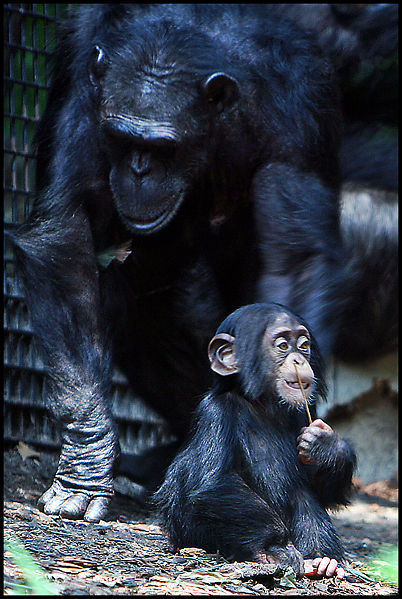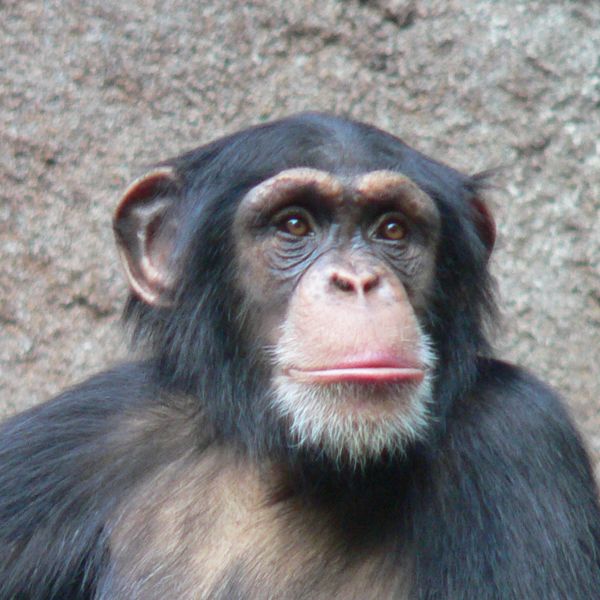Tooling around with Chimpanzees
Interview with
Adriana - These chimpanzees that I study live in the Savannah which is very different from the typical forest habitat that you see in documentaries. They have a very harsh, 6-month long, dry season. We're trying to figure out how they can make a living there. I spent 2 years in Tanzania studying these chimpanzees and during this time, I discovered a new kind of tool use.
We know that chimpanzees use tools in many different contexts, but this specific kind of tool use had not been reported before. They were using tools to dig up roots like potatoes and this behaviour is very interesting because it was one of the behaviours that people used to believe was uniquely human. There has been a lot of debate about what made us human - if it was the eating meat, the hunting, or digging for tubers, like the hunter gatherers in Africa or other parts of the world still do today.
Chris - So why had this been missed before? Why had no one seen the chimpanzees doing this?
Adriana - Because tool use in chimpanzees is not present in all the populations. Different chimpanzee populations have different types of tools. So we have never studied this population before. Before my study, this place called Ugalla had only been in short term surveys and I was the first one that was there long term, so for 2 years. And because the chimpanzees are not used to humans, that means we cannot follow them and we cannot observe their behaviour all the time. I was also trained as an archaeologist, so the discovery was based on indirect evidence. We found the holes that they have dug up with knuckle prints from their hands, with faeces, with hairs, with finger marks, and of course, we had heard chimpanzees vocalising from those sites, and when we arrived there, the chimpanzees were gone, but the material evidence was left there.
Chris - And the tools they use, tell us about those.
 Adriana - The tools are very incipient. That means they are not very developed. For example, hunter-gatherers using tools also for getting tubers, the tools are very long, are heavy, are sticks, usually hardened by fire in the deep. These tools the chimpanzees are using are expedient in the sense that they are very new. We don't think they had been using them for very long. They are very varied. Some of them were pieces of a log that had fallen down. Others were pieces of bark that they just scraped the soil off, we think and then when it got easier, they dug by hand. So, we are thinking that this is a behaviour that has not been around for very long. So it has been discovered not very long ago. They haven't had time to have very complex tools to do such behaviour. But the fact that they are using these tools and getting these resources makes it very interesting.
Adriana - The tools are very incipient. That means they are not very developed. For example, hunter-gatherers using tools also for getting tubers, the tools are very long, are heavy, are sticks, usually hardened by fire in the deep. These tools the chimpanzees are using are expedient in the sense that they are very new. We don't think they had been using them for very long. They are very varied. Some of them were pieces of a log that had fallen down. Others were pieces of bark that they just scraped the soil off, we think and then when it got easier, they dug by hand. So, we are thinking that this is a behaviour that has not been around for very long. So it has been discovered not very long ago. They haven't had time to have very complex tools to do such behaviour. But the fact that they are using these tools and getting these resources makes it very interesting.
Chris - What do we know about how the chimps pass on the knowledge? Did they do it by passive observation - I watch you use that pencil to write on that bit of paper and I therefore work out how to do the same or is there active teaching going on? Does a mother take a child and actively encourage it to do the same behaviour or don't we know?
Adriana - We know that from populations where the subjects are used to humans so you can observe them. A lot of the tool use is by observations of the mother usually using the tools. Since chimpanzees live in a fission / fusion society, that means they never - the group never - travels together all the time, but they divide into small parties and then these parties change in composition by minutes or hours, or days. So you are never with the same chimpanzees, but the only constant is the mother. Dependent offspring always travel with the mother, so they have a lot of opportunity to learn by watching how the mothers uses the tools. We also know that mothers facilitate tool using. For example, when they crack nuts with a stone, anvils and hammers, they leave the tools for the infants to use. They also have been observed to place the nut in a specific way to make the hammering more successful and there has been some reports of active teaching but it has not been very common. People need to see more of this evidence to actually say that, yes, they do have active teaching.
Chris - If you can work out how the chimps evolve this fairly new behaviour from scratch, does that tell us anything about how we, or at least our early ancestors, evolved to use tools?
Adriana - We actually think that tool use probably evolved many times in our evolutionary history, but by learning the constraints of tool use, by learning the adaptations that tool use allowed primates to have, we can learn a lot about tool use in humans and how we evolved.
Actually, I was just part of a paper which compares the oldest human technology  2.6 million years old from Gona, Ethiopia with mostly chimpanzee tools. And all of the behaviours that you can infer from the archaeological record are present in chimpanzees except for two of them which is the distance that the tools were carried, hominids carried tools for longer distances. The other behaviour that chimpanzees do not have is that hominids competed with big carnivores of that time - toothed cats, leopards, lions - and chimpanzees do not compete with these predators in Africa. So those are the only two differences that we could see and I am actually working on a paper right now about transport and it seems to be that if we go deep into what we know about chimpanzee transport, it's not so different from what we know about hominid transport. So, it may be that we will just be left with one of the differences, which is hominids competed with carnivores, but I want to make sure that we understand that this competition is not direct, but they were having access to the same food types. They were eating meat from large animals, but we don't think the competition was direct. There is a big debate if these hominids obtained the meat by hunting or scavenging and we don't know that yet. The very first hominids probably did not do much hunting.
2.6 million years old from Gona, Ethiopia with mostly chimpanzee tools. And all of the behaviours that you can infer from the archaeological record are present in chimpanzees except for two of them which is the distance that the tools were carried, hominids carried tools for longer distances. The other behaviour that chimpanzees do not have is that hominids competed with big carnivores of that time - toothed cats, leopards, lions - and chimpanzees do not compete with these predators in Africa. So those are the only two differences that we could see and I am actually working on a paper right now about transport and it seems to be that if we go deep into what we know about chimpanzee transport, it's not so different from what we know about hominid transport. So, it may be that we will just be left with one of the differences, which is hominids competed with carnivores, but I want to make sure that we understand that this competition is not direct, but they were having access to the same food types. They were eating meat from large animals, but we don't think the competition was direct. There is a big debate if these hominids obtained the meat by hunting or scavenging and we don't know that yet. The very first hominids probably did not do much hunting.










Comments
Add a comment